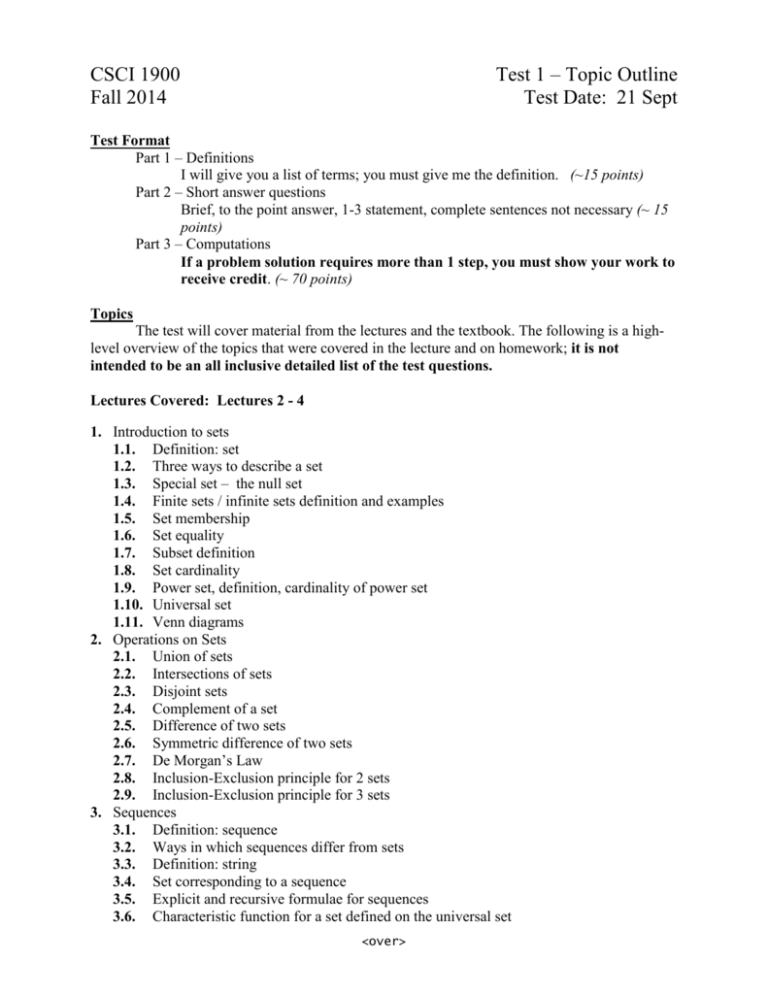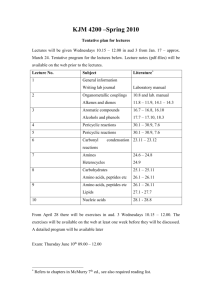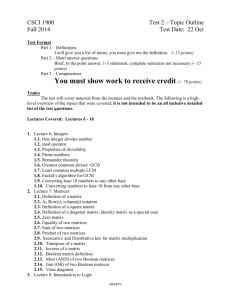Test 1 Topic Outline
advertisement

Test 1 – Topic Outline Test Date: 21 Sept CSCI 1900 Fall 2014 Test Format Part 1 – Definitions I will give you a list of terms; you must give me the definition. (~15 points) Part 2 – Short answer questions Brief, to the point answer, 1-3 statement, complete sentences not necessary (~ 15 points) Part 3 – Computations If a problem solution requires more than 1 step, you must show your work to receive credit. (~ 70 points) Topics The test will cover material from the lectures and the textbook. The following is a highlevel overview of the topics that were covered in the lecture and on homework; it is not intended to be an all inclusive detailed list of the test questions. Lectures Covered: Lectures 2 - 4 1. Introduction to sets 1.1. Definition: set 1.2. Three ways to describe a set 1.3. Special set – the null set 1.4. Finite sets / infinite sets definition and examples 1.5. Set membership 1.6. Set equality 1.7. Subset definition 1.8. Set cardinality 1.9. Power set, definition, cardinality of power set 1.10. Universal set 1.11. Venn diagrams 2. Operations on Sets 2.1. Union of sets 2.2. Intersections of sets 2.3. Disjoint sets 2.4. Complement of a set 2.5. Difference of two sets 2.6. Symmetric difference of two sets 2.7. De Morgan’s Law 2.8. Inclusion-Exclusion principle for 2 sets 2.9. Inclusion-Exclusion principle for 3 sets 3. Sequences 3.1. Definition: sequence 3.2. Ways in which sequences differ from sets 3.3. Definition: string 3.4. Set corresponding to a sequence 3.5. Explicit and recursive formulae for sequences 3.6. Characteristic function for a set defined on the universal set <over> 3.7. 3.8. Properties of characteristic functions Countable versus uncountable sets Suggested Order of Study 1. Carefully review the lectures, for the purpose of making a list of all terms and their definitions. 2. Learn those definitions. 3. Review all homework problems. Problems in Part 3 of the test will be similar to but not identical to the homework. 4. Work the review problem, without referring to your notes, your book, or previously worked homework problems. Use the review problems as a tool to identify weaknesses. 5. Download a clean copy of the ALSs relevant to the test. Complete the ALSs without referring to your notes, your book, or previously worked homework problems. 6. Review the lecture slides and your class notes. 7. Get a good night sleep. <over>











